| Weight | 1 lbs |
|---|---|
| Dimensions | 9 × 5 × 2 in |
| host | mouse |
| isotype | IgG2a |
| clonality | monoclonal |
| concentration | concentrate, predilute |
| applications | IHC |
| reactivity | human |
| available size | 0.1 mL, 0.5 mL, 1 mL concentrated, 7 mL prediluted |
mouse anti-CD45RO monoclonal antibody (UCHL-1) 6099
Price range: $160.00 through $528.00
Antibody summary
- Mouse monoclonal to CD45RO
- Suitable for: Immunohistochemistry (formalin-fixed, paraffin-embedded tissues)
- Reacts with: Human
- Isotype:IgG2a
- Control: Tonsil or lymph node
- Visualization: Cell membrane
- 0.1, 0.5, 1.0 mL concentrated, 7 mL prediluted
mouse anti-CD45RO monoclonal antibody UCHL-1 6099
| target relevance |
|---|
| Protein names Receptor-type tyrosine-protein phosphatase C (EC 3.1.3.48) (Leukocyte common antigen) (L-CA) (T200) (CD antigen CD45) |
| Gene names PTPRC,PTPRC CD45 |
| Protein family Protein-tyrosine phosphatase family, Receptor class 1/6 subfamily |
| Mass 147486Da |
| Function FUNCTION: Protein tyrosine-protein phosphatase required for T-cell activation through the antigen receptor (PubMed:35767951). Acts as a positive regulator of T-cell coactivation upon binding to DPP4. The first PTPase domain has enzymatic activity, while the second one seems to affect the substrate specificity of the first one. Upon T-cell activation, recruits and dephosphorylates SKAP1 and FYN. Dephosphorylates LYN, and thereby modulates LYN activity (By similarity). Interacts with CLEC10A at antigen presenting cell-T cell contact; CLEC10A on immature dendritic cells recognizes Tn antigen-carrying PTPRC/CD45 receptor on effector T cells and modulates T cell activation threshold to limit autoreactivity. {ECO:0000250, ECO:0000269|PubMed:11909961, ECO:0000269|PubMed:16998493, ECO:0000269|PubMed:2845400, ECO:0000269|PubMed:35767951}.; FUNCTION: (Microbial infection) Acts as a receptor for human cytomegalovirus protein UL11 and mediates binding of UL11 to T-cells, leading to reduced induction of tyrosine phosphorylation of multiple signaling proteins upon T-cell receptor stimulation and impaired T-cell proliferation. {ECO:0000269|PubMed:22174689}. |
| Catalytic activity CATALYTIC ACTIVITY: Reaction=O-phospho-L-tyrosyl-[protein] + H2O = L-tyrosyl-[protein] + phosphate; Xref=Rhea:RHEA:10684, Rhea:RHEA-COMP:10136, Rhea:RHEA-COMP:20101, ChEBI:CHEBI:15377, ChEBI:CHEBI:43474, ChEBI:CHEBI:46858, ChEBI:CHEBI:61978; EC=3.1.3.48; Evidence={ECO:0000255|PROSITE-ProRule:PRU10044}; |
| Subellular location SUBCELLULAR LOCATION: Cell membrane {ECO:0000269|PubMed:12676959, ECO:0000269|PubMed:22174689}; Single-pass type I membrane protein {ECO:0000255}. Membrane raft {ECO:0000269|PubMed:12676959}. Synapse {ECO:0000269|PubMed:35767951}. Note=Colocalized with DPP4 in membrane rafts. {ECO:0000269|PubMed:12676959}. |
| Tissues TISSUE SPECIFICITY: Isoform 1: Detected in thymocytes. Isoform 2: Detected in thymocytes. Isoform 3: Detected in thymocytes. Isoform 4: Not detected in thymocytes. Isoform 5: Detected in thymocytes. Isoform 6: Not detected in thymocytes. Isoform 7: Detected in thymocytes. Isoform 8: Not detected in thymocytes. {ECO:0000269|PubMed:11975983}. |
| Structure SUBUNIT: Binds GANAB and PRKCSH (By similarity). Interacts with SKAP1 (PubMed:11909961). Interacts with DPP4; the interaction is enhanced in an interleukin-12-dependent manner in activated lymphocytes (PubMed:12676959). Interacts with CD53; this interaction stabilizes PTPRC on the membrane and is required for optimal phosphatase activity (PubMed:35767951). {ECO:0000250|UniProtKB:P06800, ECO:0000269|PubMed:11909961, ECO:0000269|PubMed:12676959, ECO:0000269|PubMed:35767951}.; SUBUNIT: [Isoform 1]: Interacts with CLEC10A. {ECO:0000269|PubMed:16998493}.; SUBUNIT: [Isoform 2]: Does not interact with CLEC10A. {ECO:0000269|PubMed:16998493}.; SUBUNIT: [Isoform 3]: Interacts with CLEC10A. {ECO:0000269|PubMed:16998493}.; SUBUNIT: [Isoform 5]: Interacts with CLEC10A. {ECO:0000269|PubMed:16998493}.; SUBUNIT: [Isoform 7]: Interacts with CLEC10A. {ECO:0000269|PubMed:16998493}.; SUBUNIT: (Microbial infection) Interacts with human cytomegalovirus protein UL11; the interaction is required for binding of UL11 to T-cells. {ECO:0000269|PubMed:22174689}. |
| Post-translational modification PTM: Heavily N- and O-glycosylated. {ECO:0000269|PubMed:19159218, ECO:0000269|PubMed:19349973}. |
| Domain DOMAIN: The first PTPase domain interacts with SKAP1. |
| Involvement in disease DISEASE: Multiple sclerosis (MS) [MIM:126200]: A multifactorial, inflammatory, demyelinating disease of the central nervous system. Sclerotic lesions are characterized by perivascular infiltration of monocytes and lymphocytes and appear as indurated areas in pathologic specimens (sclerosis in plaques). The pathological mechanism is regarded as an autoimmune attack of the myelin sheath, mediated by both cellular and humoral immunity. Clinical manifestations include visual loss, extra-ocular movement disorders, paresthesias, loss of sensation, weakness, dysarthria, spasticity, ataxia and bladder dysfunction. Genetic and environmental factors influence susceptibility to the disease. {ECO:0000269|PubMed:11101853}. Note=Disease susceptibility may be associated with variants affecting the gene represented in this entry.; DISEASE: Immunodeficiency 105, severe combined (IMD105) [MIM:619924]: An autosomal recessive disorder characterized by recurrent infections in early infancy, decreased or absent numbers of non-functional T cells, normal or increased levels of B cells, hypogammaglobulinemia, and normal or low NK cells. Clinical manifestations may include pneumonia, dermatitis, and lymphadenopathy. {ECO:0000269|PubMed:10700239, ECO:0000269|PubMed:11145714, ECO:0000269|PubMed:22689986}. Note=The disease is caused by variants affecting the gene represented in this entry. |
| Target Relevance information above includes information from UniProt accession: P08575 |
| The UniProt Consortium |
Data
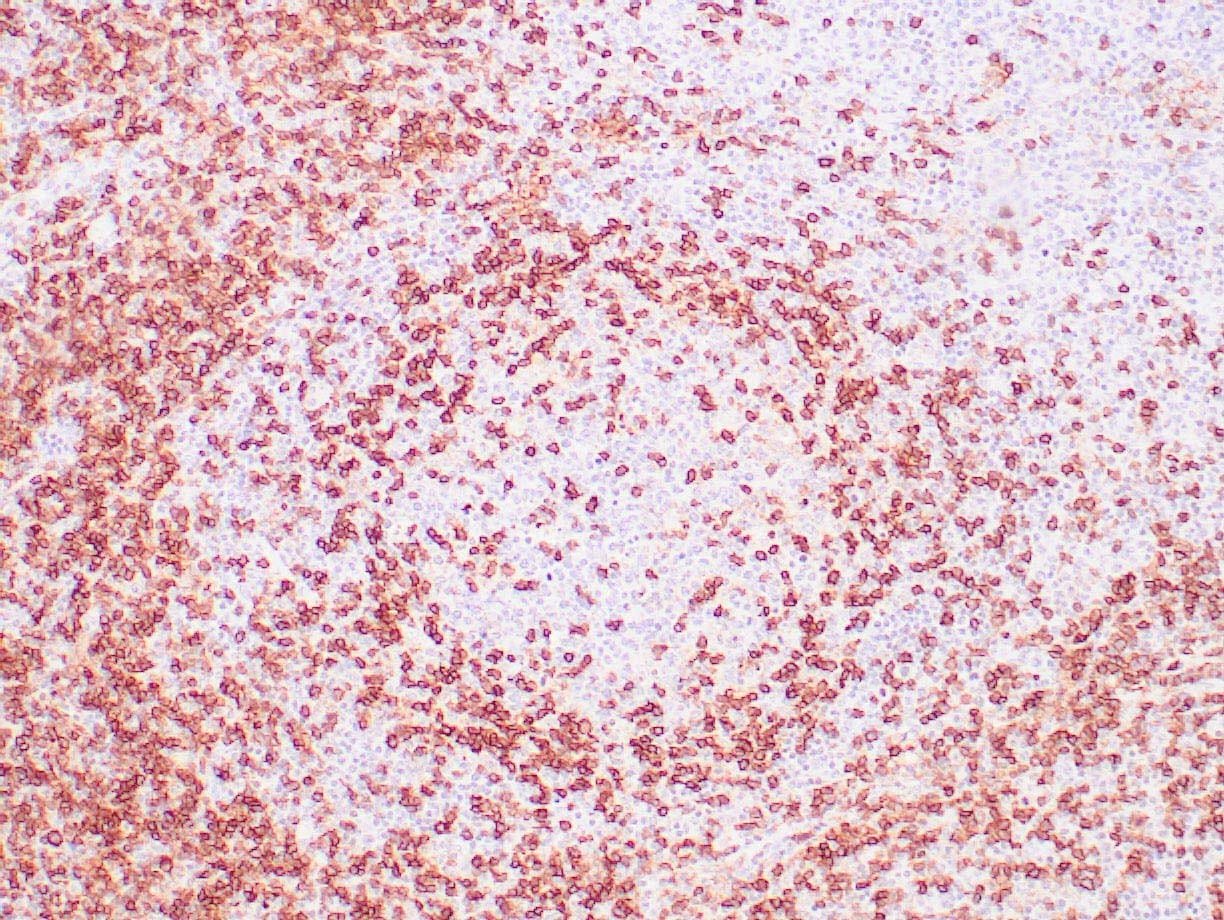 |
| Human lymph node stained with anti-CD45RO antibody using peroxidase-conjugate and DAB chromogen. Note cell membrane staining of T lymphocytes. |
Publications
| pmid | title | authors | citation |
|---|---|---|---|
| We haven't added any publications to our database yet. | |||
Protocols
| relevant to this product |
|---|
| IHC |
Documents
| # | SDS | Certificate | |
|---|---|---|---|
| Please enter your product and batch number here to retrieve product datasheet, SDS, and QC information. | |||
Only logged in customers who have purchased this product may leave a review.
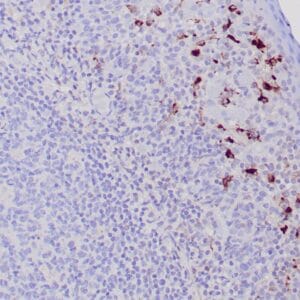
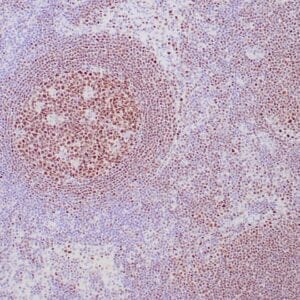
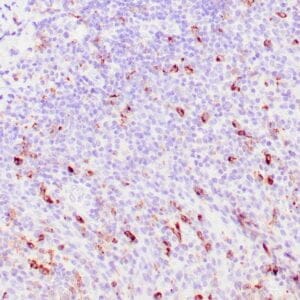
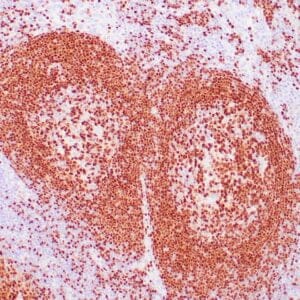
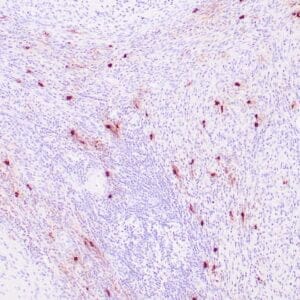
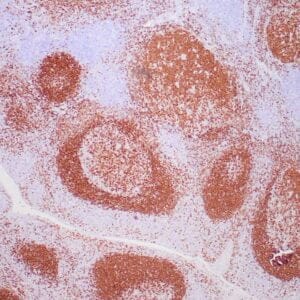
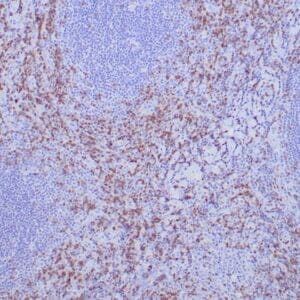
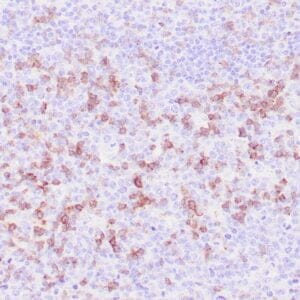
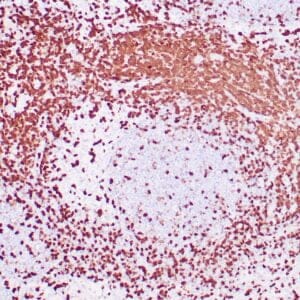
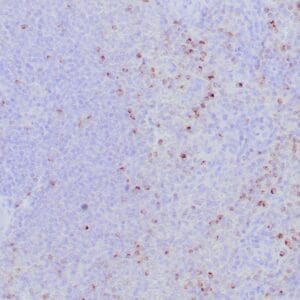
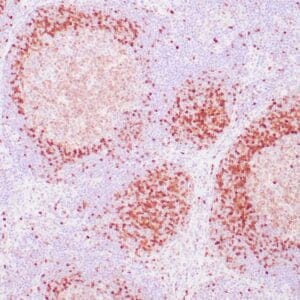
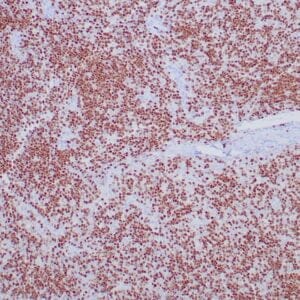
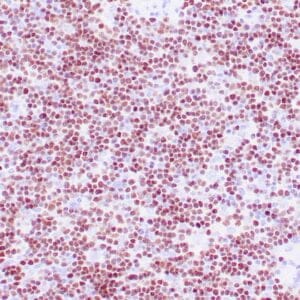
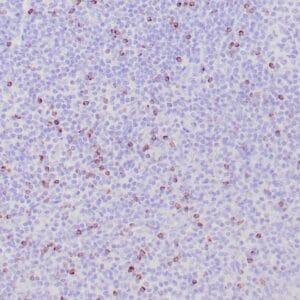
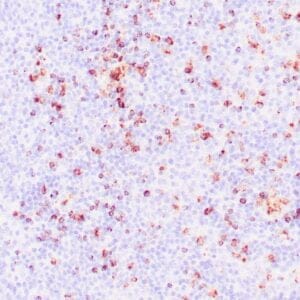
Reviews
There are no reviews yet.